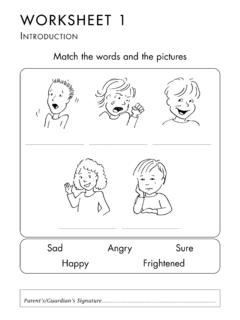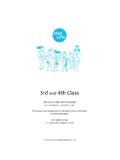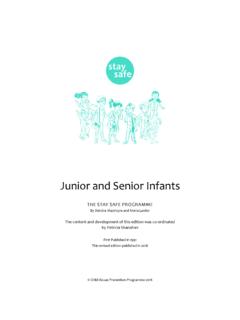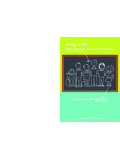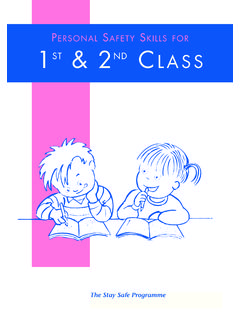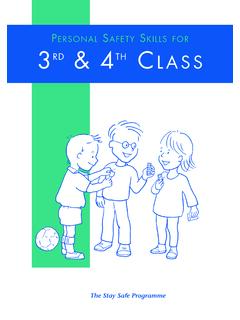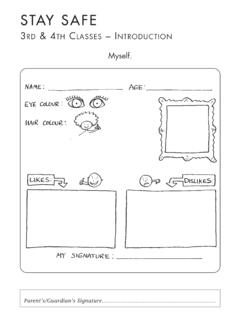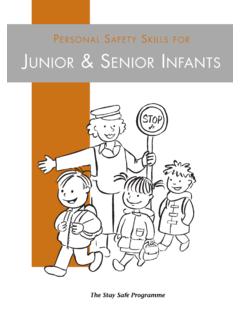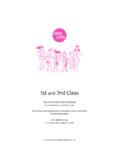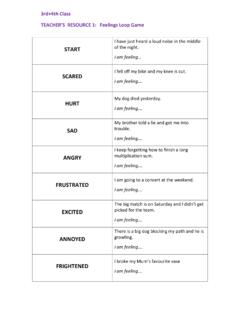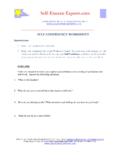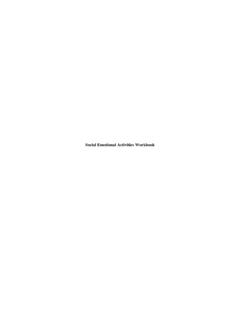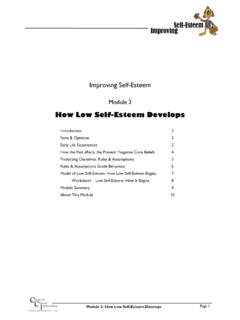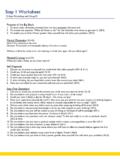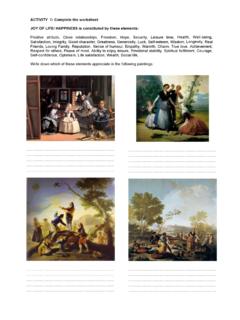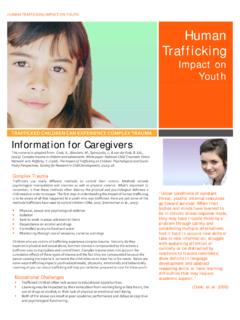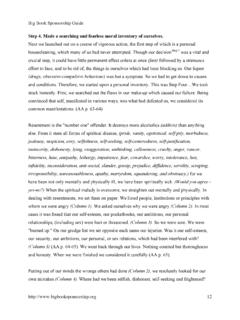Transcription of PERSONAL SAFETY SKILLS FOR C SPECIAL …
1 SPECIALEDUCATIONALNEEDSPERSONALSAFETYSKI LLSFORCHILDRENWITHThe Stay Safe ProgrammePERSONALSAFETYSKILLS FORCHILDREN WITHSPECIALEDUCATIONALNEEDSB ased on THE STAY SAFE PROGRAMMEby Maria LawlorDeirdre MacIntyreAdapted for use in SPECIAL education byRose Cullen Child Abuse Prevention Programme (1996)AcknowledgmentsThe Child Abuse Prevention Programme ( )would like to thank all those who contributed to thedevelopment of this pack and in particular to theprofessionals working in SPECIAL schools whoprovided us with invaluable feedback throughout thevarious stages of the development of the thanks are also due to the members of team who assisted in the production of Safe PERSONAL SAFETY SKILLS for children withspecial educational needs 2009 of the ChildAbuse Prevention byJean Langley Graphic Design Services087 2249752 Illustrations by Barbara 2 Preparatory WorkPage 6 How to use the Teaching MaterialsPage 12 Lessons for Children with Visual ImpairmentPage 16 Lessons for Children with Physical DisabilityPage 30 Lessons for Children with General Learning
2 DifficultiesPage 46 Lessons for Children with Hearing ImpairmentPage 60 Lessons for Children with Social, Emotional and Behavioural DifficultiesPage 76 Resource ListPage 92 WorksheetsPage 94 CONTENTSINTRODUCTIONThis handbook is designed to assist teachers inintroducing PERSONAL SAFETY SKILLS to children withspecial educational needs. Depending on the natureof their specific learning difficulties, children withspecial educational needs may require additionalinstruction in PERSONAL SAFETY SKILLS and/or a moreintensive and individualised approach. While themainstream Stay Safe Programme may proveadequate for some children with disability, a moreneeds-specific approach is required for most childrenin SPECIAL education. The development of thissupplementary material involved consultation withparents, teachers and child care staff in specialeducation.
3 It is targeted at children with SPECIAL educationalneeds in the 6-12 age group. However, theprogramme may also be suitable for some olderchildren with SPECIAL needs. For older children it isrecommended that the programme would beintroduced within the context of a Relationships andSexuality awareness of the problem of child abuse andin particular child sexual abuse has advancedconsiderably. American and Canadian studiessuggest that children with disabilities are from threeto seven times more likely to experience sexual abuse(Briggs, 1995:17).Children with disability may be more vulnerable toabuse for a variety of reasons: They may come into contact with a multiplicity ofcarers and care settings. Some are dependent onadults for their intimate care on a daily can make the task of distinguishing betweenappropriate and inappropriate touching moredifficult.
4 Children with developmental disabilities may beat higher risk of sexual abuse (see research quotedin Briggs, 1995). Children with a physical disability or a visualimpairment may be at greater risk due to theirlack of mobility. Some children with speech and hearingimpairments can be more vulnerable becausethey may not be able to tell or their attempts attelling may be misunderstood. Children with challenging behaviour may be atincreased risk of physical abuse. Children with SPECIAL needs may be overprotected. This can result in passivity andcompliance, and an over-reliance on adults for alltheir needs. Attitudes to disability in society may confirm achild s feeling of being different or inferior. Thiscan increase the child s desire to be accepted,therefore leading to greater vulnerability.
5 Taking into consideration the reasons outlined abovethe Child Abuse Prevention Programme recommendsthe following measures to all schools who intendintroducing PERSONAL SAFETY SKILLS to children withspecial educational - School Personnel It is important that all school personnel are involvedin comprehensive training before the introduction ofthe programme. Training should include: Understanding child abuse and neglect. Exploration of the reasons children with specialeducational needs may be more vulnerable. Identification of preparatory work to becompleted with the children prior to teaching theStay Safe Lessons. Consideration of how PERSONAL SAFETY SKILLS can beintegrated into the curriculum. Familiarisation with the Stay Safe Lessons,including a detailed plan of how the lessons couldbe taught to the particular children in the schoolor class.
6 A review of the procedures for dealing withallegations or suspicions of child abuse. Thiswould ensure that all personnel are clear aboutthe procedure they should follow in the event of acase coming to the attention of a member of staff. Review or drawing up of a code of good practicefor school personnel to ensure that staffrelationships with pupils are appropriate to theINTRODUCTION2age, gender and ability of the pupils. Wherepupils need intimate care it is recommended thatstaff draw up basic rules for safe touching. Parentsand pupils should be made aware of these rules. Parents education and education for ancillarystaff and voluntary workers where relevant, onpersonal SAFETY for children. Provision of a support network within the schoolfor all personnel in relation to the problem ofchild abuse and disability.
7 Incorporating child abuse prevention into theschool - Parents Parental participation is built into the Safe - a Parents Guide, published by the ChildAbuse Prevention Programme, is available to allparents. also provides parent education onStay Safe and related objectives of this training are: To ensure that families have accurate knowledgeon child abuse. To inform parents about their vital role inprotecting children from child abuse and toremind them that extra vigilance is needed whena child has a disability. To enable parents to help their children in thefollowing areas:- Expressing their feelings- Self-esteem and assertiveness- Social SKILLS and appropriate greetings- PERSONAL boundaries and body space. To enhance communication and assist children toconfide in their parents.
8 Children will only tellabout serious matters if they have experienced apositive response to minor problems which theyhave encountered. To enable parents to help their children acquirepersonal SAFETY SKILLS by familiarising them withthe Stay Safe lessons. To provide a supportive environment in whichfamilies can look at the problem of child abuseand disability and can ask any questions theymay have. NoteParental reinforcement of the PERSONAL SAFETY SKILLS athome is crucial to the success of the the Stay Safe Programme should form part ofa broader Social and PERSONAL DevelopmentProgramme which would also include Relationshipsand Sexuality Education. If RSE is not included aspart of this broader curriculum, parents, carers andteachers should ensure that children have a basicunderstanding of body parts and their of the preparatory work which is suggestedbelow could be included in this broader personaldevelopment curriculum and is not specific to theStay Safe Lessons.
9 FeelingsBefore introducing the Stay Safe Lessons it isimportant that children can name and recognisevarious feelings and that they have ampleopportunities to discuss the topic of feelings ingeneral. Such discussions can be integrated across thecurriculum including oral and written languagedevelopment, religious education, drama, poetry andstories. Parents, teachers and carers can help childrenunderstand that our feelings tell us how we are onthe inside , by encouraging them to describe howthey are feeling on a regular basis. Ask the children to think of times when they felthappy, confident and safe. Ask them to think oftimes when they felt unhappy, frightened, lonely orunsure. Photographs of class outings or of familyactivities could help the children to talk about howthey felt on those occasions.
10 What if you were watching a horror film, how wouldyou feel?What if your friends forgot to invite you to a party,how would you feel?What if your family organised a surprise birthdayparty for you, how would you feel?What if you spent a long time working at(appropriate activity), how would you feel when youwere finished? (see worksheet no. 1). Self-esteem To ensure the successful introduction of theprogramme it is important that teachers, parents andother significant adults in the child s life use everypossible opportunity to develop the children s self-esteem and confidence. Ideally the activities shouldbe integrated across the curriculum. Using similarstrategies in school, home and in the care settingwhere relevant, is important. The family remains the most important learningenvironment for the child.
